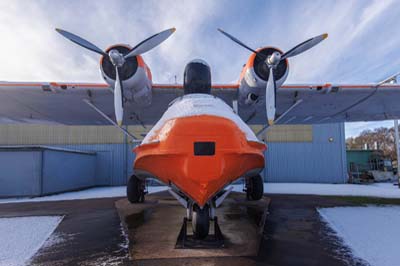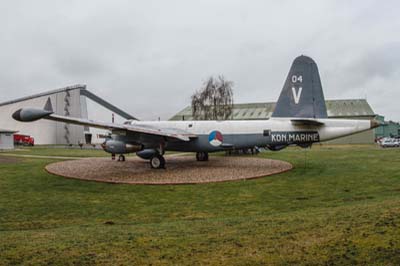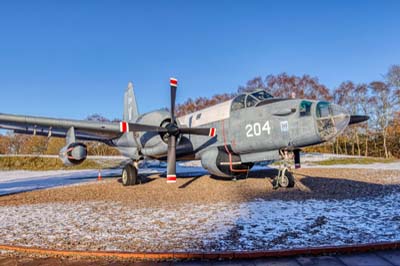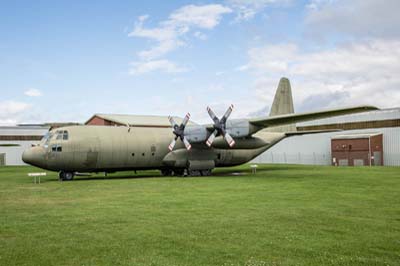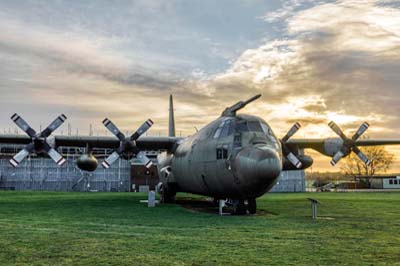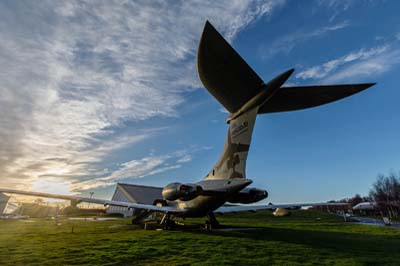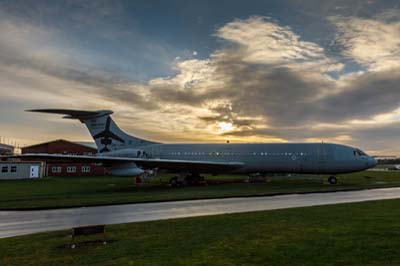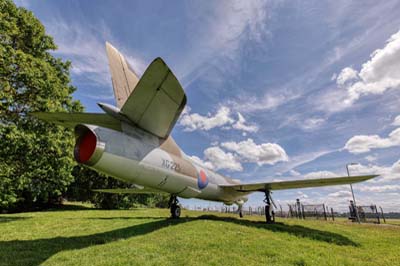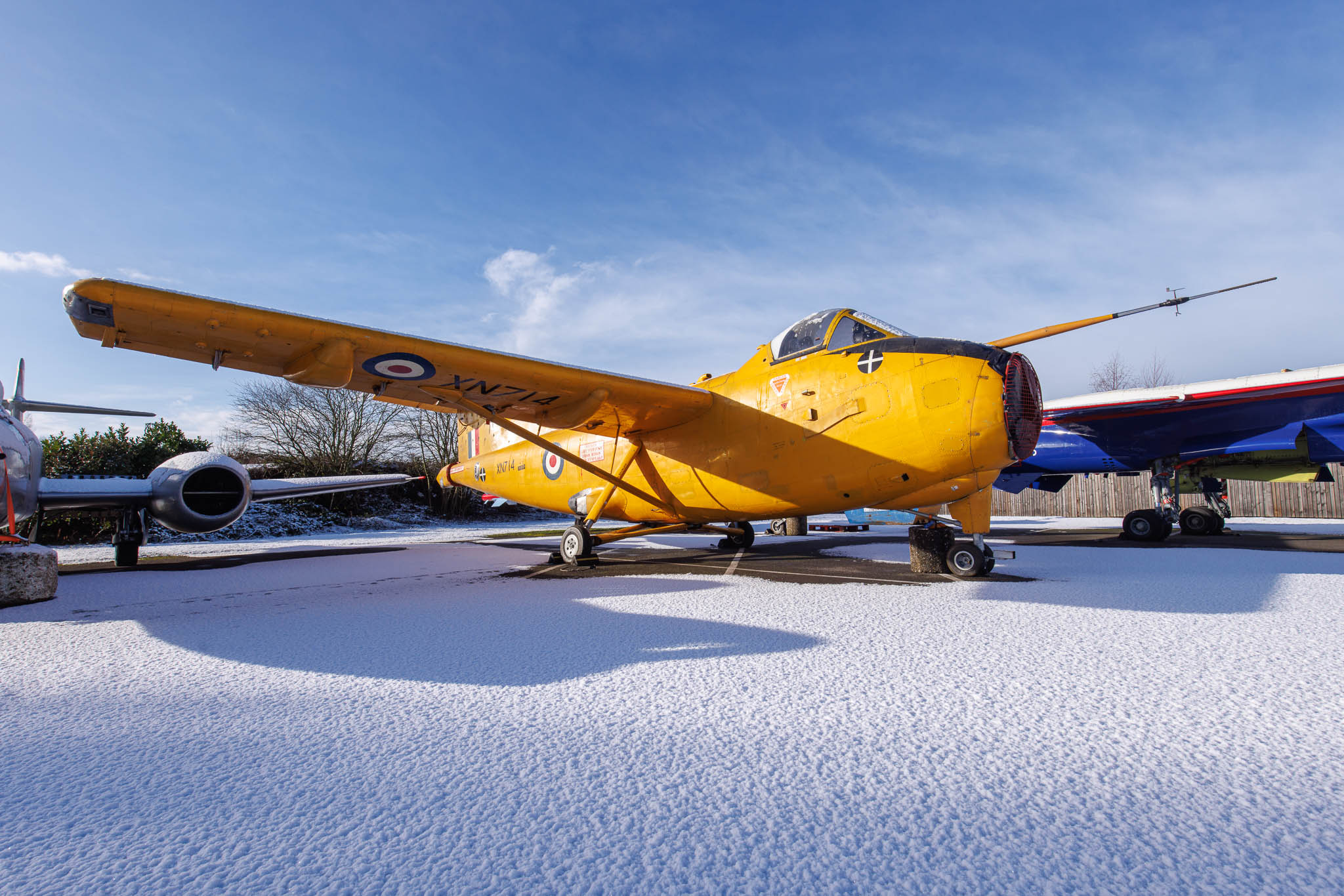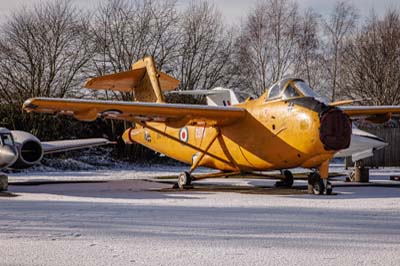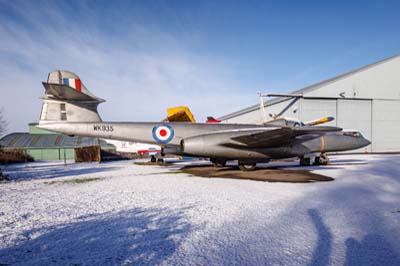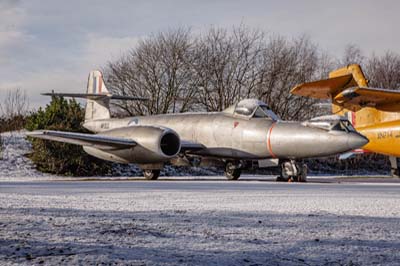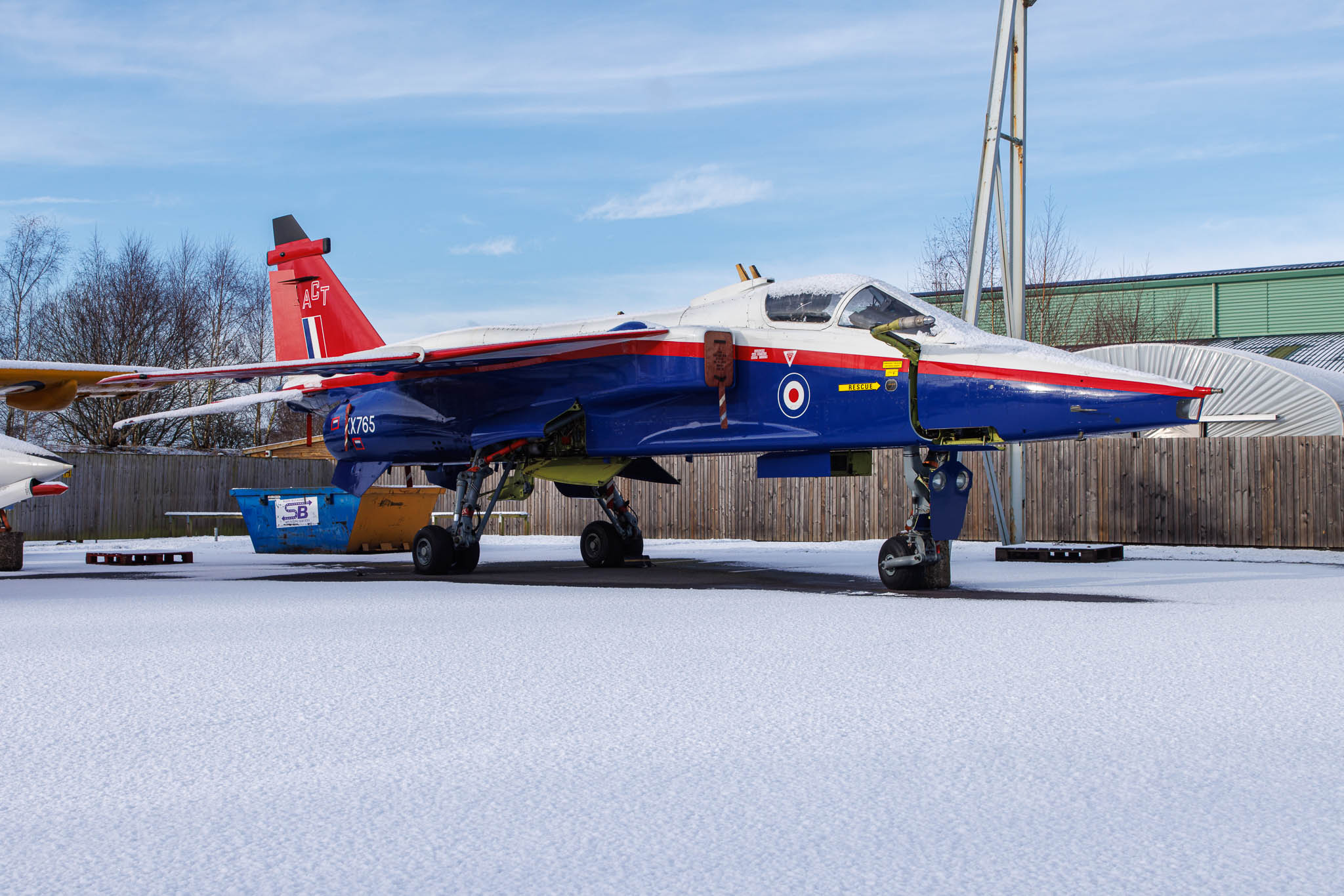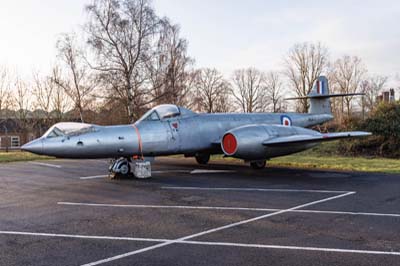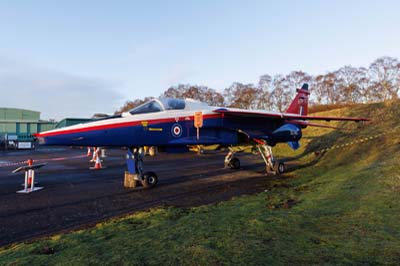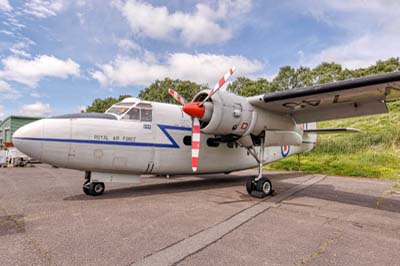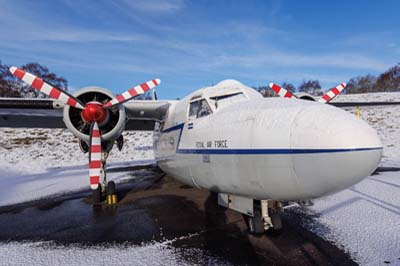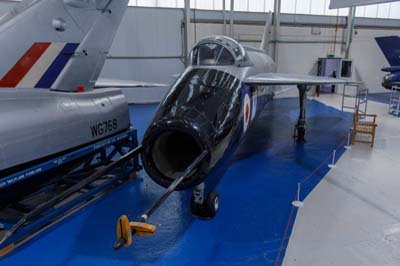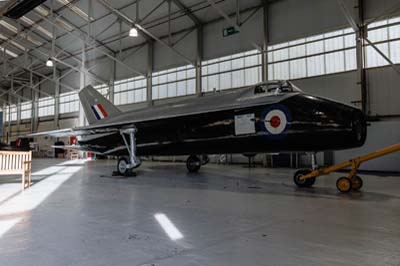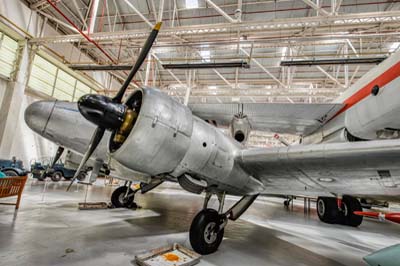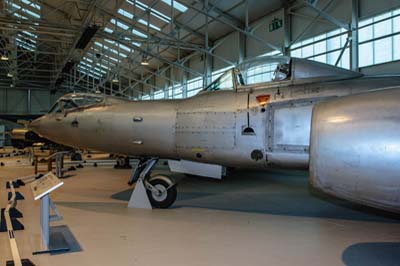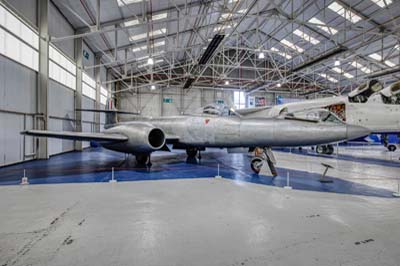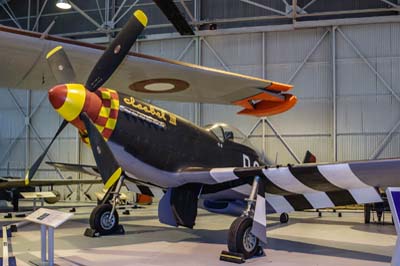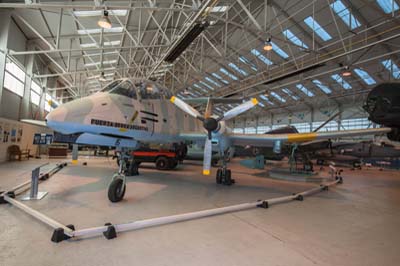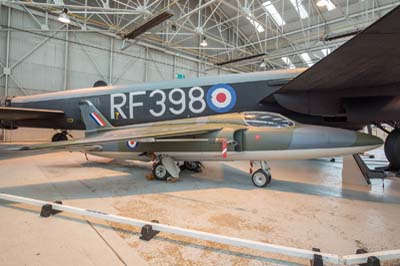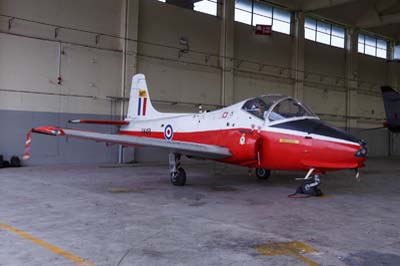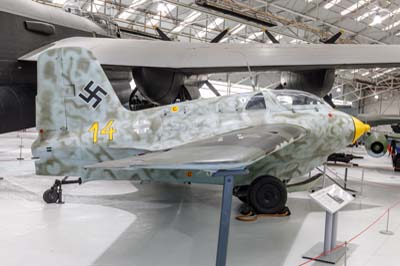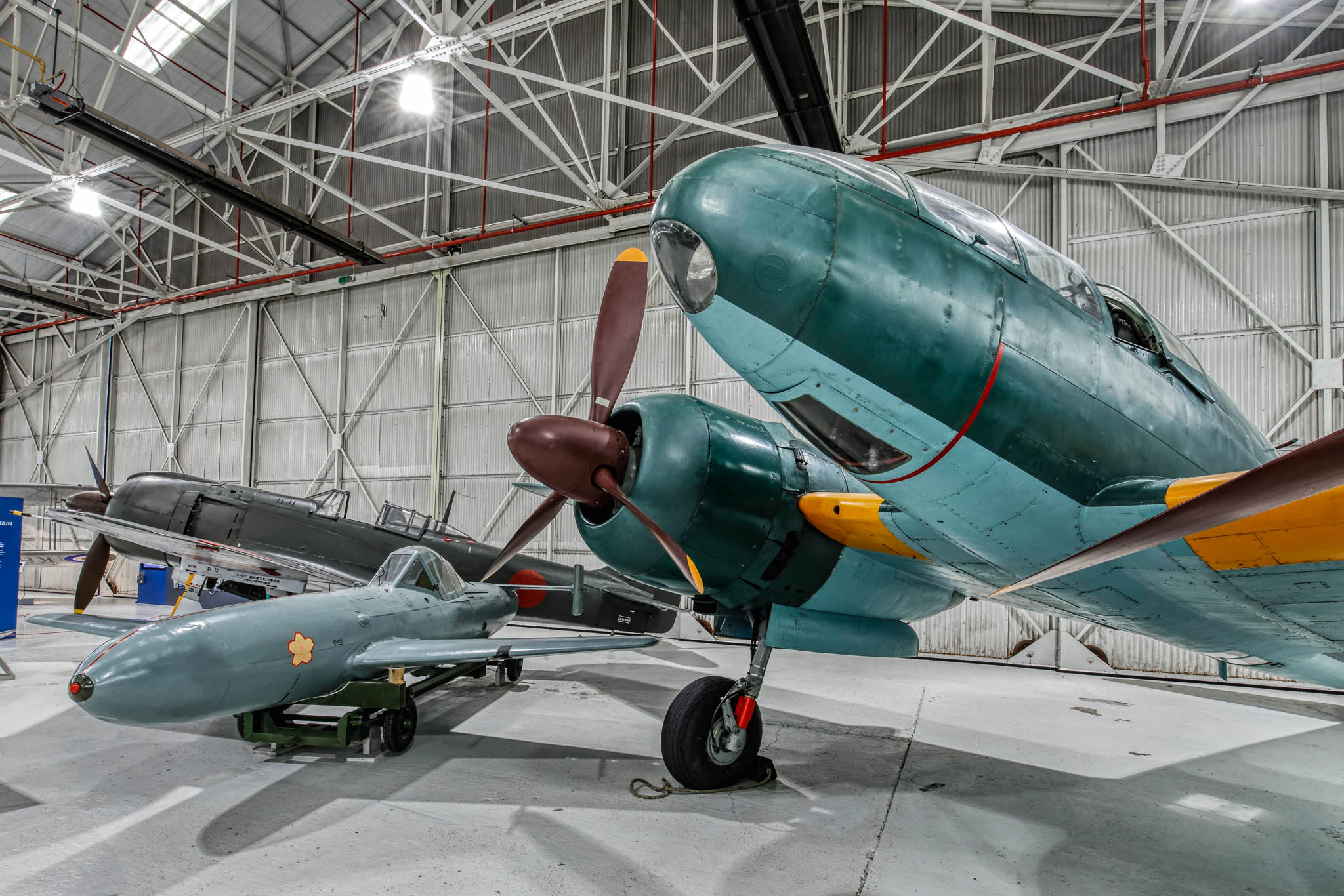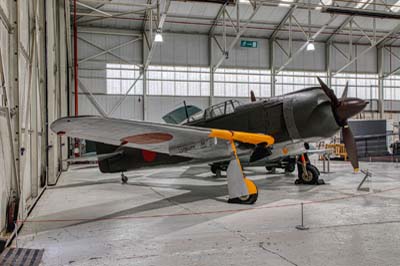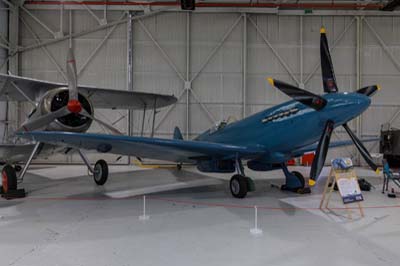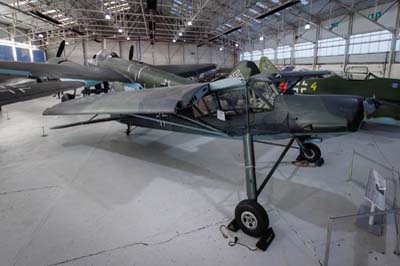Royal Air Force Museum
RAF Cosford
2003 - 2025
|
| Bristol 175 Britannia 312F (G-AOVF painted as 'XM497'). The Britannia was designed as a medium to long-range airliner. Powered by four turbo-prop engines it was nicknamed the 'whispering giant'. The aircraft first flew in July 1956. With the advent of jet powered airliners the Britannia failed to compete and by 1960, when production ended, only 85 had been built. The RAF bought 23 Britannia C.1/C.2s which they operated until 1975. The Britannia continued to fly until the 1990s. The example on display was ordered by BOAC and later flew with British Eagle, Donaldson, IAS and Invicta. As photographed in 1988. |
 |
| Consolidated PBY-6A Catalina (L-866 ex Royal Danish Air Force). This very successful flying boat took to the air for the first time in March 1935. It was designed as a patrol bomber and had a very long range. Over 4,000 Catalinas were built, the later models were fitted with retractable tricycle undercarriage. Excelling in the maritime reconnaissance role they continued in service for many decades. The example on display was transferred to the Royal Danish Air Force in 1957 and remained in service until the 1970s. It arrived at Cosford in 1975. |
 |
Lockheed SP-2H Neptune (204 'V'). The P-2H Neptune was designed in the World War Two as a land based maritime patrol and anti-submarine aircraft, eventually 1,100 were built and were operated by many air forces around the world, including the RAF and Royal Netherlands Navy (Koninklijke Marine).
Neptune 204 was built in 1961 for the Koninklijke Marine and delivered directly to Dutch New Guinea for service with 321 Squadron. Initially employed on reconnaissance patrols, it also carried out limited anti-shipping and bombing missions against insurgent forces. In 1962, the aircraft was transferred to the Netherlands to join 320 Squadron. Over the following 19 years, it operated in the East Indies and took part in numerous NATO exercises and patrol missions. It became one of the last two Neptunes to remain in Dutch service before being retired in 1982.
That same year, the Dutch Navy presented the aircraft to the Aerospace Museum at RAF Cosford on long-term loan, where it has remained on external display ever since. 204 was fully repainted in 2000 and officially transferred to the ownership of the RAF Museum in 2007.
Unfortunately, by 2025 204 was listed for disposal by the RAF Museum and is available for acquisition by another museum.
|
 |
| Hawker Siddeley Nimrod R.Mk.1(XV249) was transported to RAFM Cosford in 2012 and once reassembled was put on display in 2015. |
| Hawker Siddeley Dominie T.1 (XS709 'M') First flew in December 1964, it was based HS 125 executive jet. It was finally retired with the rest of the remaining fleet at RAF Cranwell in 2011 and wsa almost immediately flown to Cosford for display. |
| Lockheed Hercules C-130K Mk3 (XV202) was delivered in 1967 and served until 2011 when it was delivered from RAF Brize Norton directly to Cosford for display. |
| Vickers VC-10 C.1K (XR808) The VC-10 served with the RAF for 47 years, the last flights was in September 2013. XR808 served with 10 squadron from RAF Brize Norton and was given the name Bob based on the 808 in the serial. It arrived at Cosford by road in June 2015 and was assembled and put on display in November 2015. |
| Hawker Siddeley Hunter F.6A (XG225) Based on the Hawker Sea Hawk, the first production Hunter F.1 flew in 1951, following flight testing of the P.1052 and P.1081 test aircraft. Eventually 1,972 Hunters were built serving with 19 air forces to 1994. A single seat fighter, 415 Hunter F.6s were produced, some 380 of them for the RAF. XG225 first flew in 1956 and finally retired and put into storage in 1980 as 8713M moving to Cosford in 1988 and moved to the entrance in 2004. As photographed in 2002. |
| In January 2023 five aircraft were towed outside of hangar 1 to allow contractors greater access to the building in preparation for the first part of the RAF Museum Midlands Development Programme. Apparently access to hangar 1 and 2 will resume in May 2023.
Gloster Meteor F.8 (Prone) (WK935).
Hunting H.126 (XN714).
Saunders Roe SR.53 (XD145).
SEPECAT Jaguar GR.1 ACT (XX765).
|
Left to right:
Gloster Meteor F.8 (Prone) (WK935), Hunting H.126 (XN714), Saunders Roe SR.53 (XD145) and SEPECAT Jaguar GR.1 ACT (XX765). |
| Left to right: Hunting H.126 (XN714). |
Left to right:
Gloster Meteor F.8 (Prone) (WK935). In June 2024, it was transferred on loan to the Newark Air Museum. |
| Left to right: Saunders Roe SR.53 (XD145). |
| Left to right: SEPECAT Jaguar GR.1 ACT (XX765). |
By February 2023 these four aircraft had been moved to other outside locations and now with their information display boards.
Left to right: Saunders Roe SR.53 (XD145).
Gloster Meteor F.8 (Prone) (WK935).
Hunting H.126 (XN714).
SEPECAT Jaguar GR.1 ACT (XX765). |
 |
SEPECAT Jaguar GR.1 ACT (XX765).
Museum staff and a team of volunteer aircraft engineers are required to perform an annual inspection and three lesser quarterly inspections of each aircraft on display. This is to make sure that aircraft are structurally sound. Perpetual leaks of oil and fuel also have to be managed.
Jaguar GR.1 ACT (XX765) the Active Control Technology demonstrator used to test the fly-by-wire (FBW) technology running from 1981 to 1984. It has developed an oil leak, the engineers suspect a ruptured oil seal is the cause. The challenge for them is to find exactly where the oil is leaking from. They are using a fibre optic camera to enable them to look through small inspection panels to find the source of the leak. Some panels were opened when it was operational using the aircraft's electrics but that is no longer possible, now the only panels that can be opened are bolted in place and often the layers of paint applied since it left the factory make removing the bolts more difficult. In 1996 British Aerospace repainted the airframe back into its original raspberry ripple colours after it had been painted green when on loan to Loughborough University.
Leaking oils and residual fuel leaks are corrosive and potentially flammable. An oil leak can also damage the paintwork. The museum engineer points out that external gauges on both sides of the fuselage are showing an unexpected high pressure which could be connected to the leaks and has to be investigated.
Jet powered aircraft usually have its engine "ripped" (removed) from the aircraft before it is put on display. Propellor powered aircraft retain their engines if nothing else but to "hang the prop'", on I was told. |
Left to right:
de Havilland Devon C.1 (VP952 later 8820M) undergoing and inspection for a water leak in April 2022.
Hawker Hunter FR.10 (853 (Jordan & Oman) formally XF426). XF426 was delivered to the RAF in 1955 as a F.6 variant of which 379 were built. It initially served with 208 Squadron in Cyprus before being recalled in 1959 for conversion to FR.10 standard. From 1965 it was used by A&AEE at Boscombe Down for camera trials before moving to 2 Squadron at Gutersloh in West Germany in 1967 and then to 229 OCU later in the year. In 1972 it was given to Jordan before moving on to Sultan of Oman in 1975 serving until 1993. After years of static display it was transferred to the RAFM in 2003. It was placed around the back of the museum for a while before being mounted on a plinth at the front in 2010. It left RAFM Hendon in March 2017. |
 |
 |
Left to right:
From 2021 inter-active information consoles have been placed in front of some of the exhibits. This move modernises the museum and will appeal to a great number of the visitors but they make uncluttered photography of the aircraft much harder.
Young RAF photographers are given assignments to shoot 'VIPs' to the museum as part of their training.
|
| These exhibits have been either transferred to the RAF Museum Hendon, placed into storage, or removed from the museum's collection under a disposal plan. |
Left to right:
Hunting Percival Pembroke C.1 (WV746). Entering service in 1953, the Pembroke took over from the venerable Anson in the light transport and communications role. By May 2025 it had arrived at the RAF Museum Hendon. |
| Focke-Achgelis Fa 330 'Bachstelze' (100503). It was designed as an unpowered autogyro kite towed behind German Type IXD2 U-boats for use as an observation platform. It was designed by Heinrich Focke, testing of the type began in mid-1942, and operational deployment began in early 1943, with some 200 built by Weser Flugzeugbau. It was on display at Hendon by November 2025. |
 |
Left to right:
Scottish Aviation Twin Pioneer CC.2 (XL993). The Twin Pioneer was a follow-up to the same company's single-engine short take-off and landing (STOL) transport, the Pioneer. Initially designed as a 16-passenger civil transport aircraft the Twin Pioneer first flew in 1955. The RAF ordered 39 examples which entered service in October 1958 the last aircraft on frontline duties was retired in 1968. In 1965 an additional aircraft was acquired for use by the Empire Test Pilots School.
In 1964, Twin Pioneer XL993 took part in operations in the Radfan area, supporting actions against Yemeni-backed dissident Qutebi tribesmen north of Aden. For these missions, XL993 received a unique modification: the aircraft was fitted with two Nord SS.11 wire-guided missiles, mounted on outboard underwing pylons—a rare armament configuration for the type. Operating from RAF Khormaksar, XL993 carried out two live missile-firing sorties, conducted on 1 July and 28 July 1964 in the Khormaksar area. These missions formed part of the broader British counter-insurgency campaign during the Radfan conflict, and XL993's missile trials represented one of the few occasions where a Twin Pioneer was armed for offensive operations. XL993 had made its final flight to RAF Henlow, for storage on April 6, 1969. By May 2025 it had arrived from RAFM Cosford at the RAF Museum Hendon for display. |
 |
de Havilland 106 Comet 1XB (G-APAS). The Comet was the world's first commercial jet airliner, making its maiden flight in July 1949. BOAC began operating the type in 1952, but after a series of fatal crashes caused by metal fatigue, the Comet 1 was withdrawn and extensively redesigned. The improved Comet 4 emerged four years later, but by then the Boeing 707 had taken the lead in the jet airliner market.
The aircraft on display, painted in a BOAC livery, is particularly significant as the only surviving Comet 1 in existence. Originally registered in 1953 as F-BGNZ with Air France, the aircraft was returned in 1956 and modified to correct structural issues, including the addition of a thicker fuselage skin around oval windows. Re-registered as G-APAS, it was handed to the Ministry of Supply and served as a flying laboratory until its retirement in May 1967.
Transferred to the RAF Museum in 1978, the aircraft was placed on display at Cosford. As part of the RAF Museum's policy of redistributing surplus aircraft to institutions in the UK and abroad, G-APAS was later transferred to the South Wales Air Museum in Cardiff in October 2025. Unfortunately, during preparations for road transport, when the wings were removed, severe corrosion was discovered, making them impossible to reattach. As a result, the aircraft can no longer be restored to complete condition. |
 |
Short SB.5 (WG768 later 8005M). The Short SB.5 was a British experimental aircraft developed to evaluate different wing and tail configurations for the English Electric Lightning fighter. Designed by Short Brothers, it was intended to study the low-speed performance of adjustable swept-wing layouts that could be modified directly in the field. The aircraft proved successful, and its trials played a key role in confirming the effectiveness of the Lightning's final design.
In July 1953, initial test flights began with a 60° wing sweep and a T-tail configuration. By January 1954, tests with a lower tailplane were underway to provide data before the P.1's first flight. The T-tail design was eventually deemed unsuitable, and testing with the 60° wing sweep concluded in April 1958. After completion of its test programme, the SB.5 eventually joined the fleet of the Empire Test Pilots' School (ETPS) at Farnborough in 1967. In 1971 it left RAF Finningley for RAF Topcliff leaving there in 1973.
After being moved in to Lamella Hangar 9 at RAF Cosford, WG768 was being prepared for its move to the Ulster Aviation Society in Lisburn, Northern Ireland in October 2025.
As photographed in 1988. |
 |
| de Havilland Devon C.1 (VP952 later 8820M) was designed for the RAF from the civil de Havilland Dove 4 as a light communications and transport aircraft supplied from 1947, serving till 1984 VP952 was donated to the museum in 1998. On August 7, 2025 it arrived at its new home, Gatwick Aviation Museum. |
 |
Avro Anson C.19 (TX214). The Anson was designed in 1936. 263 were built for maritime reconnaissance duties for which it quickly became obsolete when war broke out and it was more ably employed as a crew trainer and communications aircraft. By 1952 over 8,000 examples had been built by Avro in Great Britain with nearly 3,00 more built in Canada by Canadian Federal Aircraft. The Anson remained in service with the RAF until 1954 and 1968 for the later redesigned C.19 variant, with many moving on to civilian operations.
Delivered in 1946 TX214 was struck off charge on the in 1963 it was transferred to the Historical Aircraft Museum at RAF Henlow and then on to RAF Cosford Museum in 1978. In May 2025 it was transferred to the Avro Heritage Museum in Woodford, Greater Manchester. As photographed in 1989. |
 |
| Gloster Meteor F.8 (Prone) (WK935). This was the last of the 430 Meteor F.8s manufactured by Armstrong Whitworth at Bagington, Coventry. Following modifications to allow the pilot to flying the aircraft lying down in the prone position it took to the air for the first time in February 1954. The object of the exercise was to test the reduced effects of high G forces on the pilot when in the prone position. 14 flights were made from Bitteswell before it was transferred to the Institute of Medicine at Farnborough in August of that year. After a further 55 flights testing was completed by July 1955 and it was decided that the advantages of reduced effects of 'G' were out-weighed by the difficulties of flying the aircraft lying down. The test aircraft was put into storage after its final flight in 1959. It arrived at Cosford from RAF Colerne in 1977. It was transferred on loan to Newark Air Museum in June 2024. |
North American P-51D Mustang (44-73415 composite painted as '44-13573' coded 'B6-V' 'Isabel III' previously N6526D later 9133M).
Perhaps the best fighter of World War Two, the P-51 Mustang was built from 1940 by North American Aviation to a British specification. By 1941 the first Mustang was delivered to the RAF for testing. In 1942 a Rolls-Royce Merlin engine was fitted to the P-51B giving the aircraft at 30,000 feet an extra 100 mph to 440 mph over the Allison engine. In June 1944 the first of 8,000 P-51Ds with the British designed bubble canopy were produced. It had now become a vital long-range fighter escort, equipped with drop tanks, which could be jettisoned when empty of fuel, to improve the aircraft's performance. Over 2,600 Mustangs were supplied to the RAF flying with 31 squadrons during the war. They were all withdrawn from RAF service by November 1946.
This example completed a rebuild in 1989 using the fuselage from 44-73415 which had recently crashed as N6526D and completed with parts from an ex Indonesian AF P-51. It is painted as '413573' in the markings of the 8th United States Army Air Force, 357th Fighter Group, 363rd Fighter squadron at Leiston, Suffolk. It was moved to Hendon in 1991 and then to Cosford in 2003.
In 2022 the RAF Museum reported that they had reviewed their aircraft collection proposed a number of airframes for transfer including gifting them to accredited organisations. The Hunter Fighter Collection, a registered charity in Australia, made a dexcision to pursue several of the airframes advertised for gifting and submitted applications to secure them. Subsequently the above P-51D Mustang and de Havilland Vampire FB.5 (WA346) both in storage were awarded to HFC and are expected to arrive in Australia in 2023. |
 |
Henri Mignet HM.14 Pou du Ciel 'Flying Flea' (G-AEEH). The 'Flying Flea', designed in 1934 by Henri Mignet was probably the first home-built to be offered to the public for home construction. Following a number of fatal accidents and the discovery of aerodynamic design errors the French authorities banned it from flying in 1936, the British authorities following suit in 1937.
The example on display was built between 1935 and 1936 by Edgar Davis and flew from Whitchurch airfield over the next two years. It was retired in May 1938. For almost thirty years it remained in the owners garage before being loaned to the RAF Colerne Museum in 1966. In 1976 it was moved to St Athan and on to Cosford in 1994 to be restored and put on display. It was due to move to the Bournemouth Aviation Museum in early 2024. |
Left to right:
de Havilland DH-112 Venom FB.54 (J-1704) ex Swiss Air Force. The first Venom prototype flew on September 2, 1949. It served with the Royal Air Force as a single-seat fighter-bomber and two-seat night fighter. The 22 FB.54s built were purchased by Venezuela and Switzerland in the 1950s. As photographed in 1989. Currently in storage in one of the Lamella hangars ie Hangar 9 at RAF Cosford, last noted in October 2025.
Bristol 171 Sycamore HR.14 (XJ918 later 8190M). The Bristol Sycamore is one of the first production helicopters to be developed. XJ918 was relocated to the RAF Museum Cosford in 1983. By September 2021 it had been placed in storage in Hangar 9 at RAF Cosford, before its move to the Ulster Aviation Society in December in 2022. As photographed in 1988.
Westland Dragonfly HR.3 (WP495 painted as 'G-AJOV'). The Dragonfly was built from 1948 by Westland under license from Sikorsky (S-51) for the Royal Navy who had 72 and the RAF who had 15. British European Airways operated the Dragonfly for a few years in the early 1950s. Transferred to Morayvia Sci-Tech museum, Kinloss in July 2017. |
Avro 707C (WZ744). The Avro 707 was designed for research purposes with the intention of eventually using them as jet trainers, to provide pilots with experience of handling a delta-winged aircraft using fly-by-wire technology in advance of the introduction of the Avro Vulcan. The one-third scale design was the first British built delta-winged aircraft. Vital data was gathered during testing for the Avro Vulcan project. The first Avro 707A (VX784) first flew on September 4, 1949 from Boscombe Down, however tragically 26 days later while testing its slow speed handling characteristics, Eric Esler lost control and crashed he was tragically killed.
The Avro 707B (VX790) with an extended nose section flew for the first time on September 5, 1950. It flew until 1956 when it was damaged beyond economical repair in a landing accident, ending its days on the dump at RAE Bedford. Another prototype (WD280) was transported to Australia for testing in 1954 with a modified wing. It was eventually struck off charge in 1967 and is now in the RAAF Museum at Point Cook passing from a private owner in 1999. In 1951 three additional Avro 707s were ordered as two-seat (side-by-side) trainers and were designated Avro 707Cs. Only two were built (WZ736 and WZ744) as the first Vulcan's were found to be easy to fly and these trainers were deemed unnecessary. Both aircraft survived WZ736 was on display at the Manchester Museum of Science and Industry, which was closed 2021 and its collection was split up and moved to new homes. In January 2022, WZ736 was moved on to the Boscombe Down Aviation Collection at Old Sarum airfield. WZ736 photographed at Old Sarum in 2023.
WZ744 is now in storage. WZ744 first flew on July 1, 1953 from RAF Waddington eventually totalling 200 hours testing fly-by-wire electrically signalled hydraulic flying controls, it was retired in 1967. WZ744 as photographed in 1989. |
Left to right:
Scottish Aviation Pioneer CC.1 (XL703 painted as 'XL554'). The prototype first flew in 1947 with deliveries to the RAF starting in 1953. Only a small number were built mostly served in the Far East. XL703 is the sole surviving example which was delivered to the RAF in 1956, only two more followed before production ended. In 1968 it was retired and delivered to Cosford for preservation, going on display in 1989. After a period of storage in Hangar 9 at RAF Cosford it was moved to the RAF Museum at Hendon in May 2025.
FMA 1A58 Pucará (A-515 later ZD485) an Argentine ground-attack and counter-insurgency aircraft. It is a former Argentinian Air Force aircraft, captured during the 1982 Falklands war. By October 2025 it was on display at the South Yorkshire Aircraft Museum in Doncaster. |
Left to right:
BAE Harrier GR.9A (ZG477). It has a 1(F) Squadron special tail applied at the end of its service. The Harrier was the first operational jet fighter capable of vertical take-off and landing. It was utilised by the RAF in the ground attack and reconnaissance role and for Close Air Support (CAS). The GR.9A on display was the final variant and was retired in December 2010. Transfered to RAFM Hendon.
Panavia Tornado P02 (XX946 'WT') prototype. Panavia was a consortium put together by the United Kingdom, West Germany and Italy to develop a combat aircraft in three main versions; Tornado IDS (Interdictor/Strike), Tornado ECR (Electronic Combat/Reconnaissance and Tornado ADV (Air Defence Variant). 992 Tornados were built including 72 for Saudi Arabia.
The first British prototype flew in 1974 and was initially the designated the GR.1 when it entered service in 1980, 142 Tornados were later upgraded to GR.4/4A standard as a mid-life update, entering service in 1998. It still is the RAF's primary long-range strike attack aircraft and is fitted on each side of the nose two 25mm cannons. Capable of flying in all weather and at low-level, using its terrain-following, ground-mapping radar. It has Forward Looking infrared (FLIR) and linescan imaging systems to help fulfil its reconnaissance role, along with a 'RAPTOR' (Reconnaissance Airborne Pod TORnado) reconnaissance pod. For close air support and interdiction, the aircraft would be equipped with iron bombs, cluster bombs and laser-guided bombs. In the defence suppression role, it is equipped with anti-radar missiles. The Tornado GR.4/4A can also carry 'TIALD' (Thermal Imaging and Laser Designator) pod, first introduced during the first Gulf War in 1990.
XX946 was allocated to the RAF Museum in 1994 and was put on display at Hendon that year. In 2003 it was transferred to Cosford. By 2014 it was put into storage in Hangar 9 at RAF Cosford. |
Left to right:
Folland Gnat F.1 (XK724 later 7715M). The single-seat Gnat F.1 fighter was the forerunner of the successful two-seat Gnat T.1 trainer. Passed into storage in 2018 and then onto the Midland Air Museum at Coventry by December 2022.
Hawker Siddeley Gnat T.1 (XR977). First flew in August 1959 and entered service in February 1962. 105 Gnats served with the RAF until November 1978. The Red Arrows flew the Gnat from 1966 until 1979. It was transported from Cosford to Hendon in 2018. |
| British Aircraft Corporation Jet Provost T.5A (XW418 'MT' later 9173M). The Hunting Percival Jet Provost first flew in 1954 and was the first jet powered basic trainer to go into service anywhere in the world and was based on the piston powered Percival Provost. Ten T.1 variants were initially ordered followed by 201 T.3s which had an improved engine, an ejector seat and retractable tricycle undercarriage. 70 T.3s were later upgraded to T.3A standard with improved avionics. From 1961, 185 T.4s were delivered incorporating further improvements to the engine. The T.5 variant took to the air in 1967 and introduced the much needed pressurised cockpit. The first of 110 T.5s were handed over to the Central Flying School in 1969. 94 were later upgraded to T.5A standard between 1973 and 1976 with the introduction of improved avionics. XW418 finished its life with DCAE at RAF Cosford. |
| Boulton Paul Sea Balliol T.21 (WL732) Developed as an advanced trainer aircraft for the RAF (Balliol) and the Royal Navy Fleet Air Arm (Sea Balliol) in the late 1940s. 30 were supplied to the FAA from 1954 and served until 1963. Withdrawn from display and put into storage by May 2022. As photographed in 1989. |
| Messerschmitt Me 163B-1a Komet (191461 later became 'Yellow 14' after restoration). The only rocket propelled aircraft to enter service. Flying the very fast but volatile Me163, Luftwaffe pilots of Jagdgeschwader (JG) 400 managed to shoot down nine allied aircraft from August 1944. This Me163 was found at Husum airfield on May 8, 1945 and transported back to Farnborough. By July 1945 it was in store at Brize Norton eventually finding its way to Cosford in 1975. It had transferred to Hendon by April 2022. |
| The Japanese World War Two collection were transferred to RAFM Hendon towards the end of 2022. |
| Mitsubishi Ki-46-III 'Dinah'. Designed as a fighter and for ground attack it later excelled as a high-altitude reconnaissance aircraft, its first flight was in 1939. This rare example was captured and passed to the Allied Technical Air Intelligence Unit in South East Asia at Tebrau along with a number of Japanese aircraft, four of which were selected for shipment to the UK. This aircraft was never to fly again, eventually leaving storage in 1989 to go to Cosford. Here it was extensively restored (1992-1994) with help from Mitsubishi of Japan and put on display. It was moved to Hendon in October 2022. |
| Kawasaki Ki-1001b (c/n 16336). The first prototype made its maiden flight on February 1, 1945. 272 were built from stored Ki61s with another 118 built from scratch up to June 1945, this example on display is the only one to survive. It had moved to Hendon by October 2022. |
Yokosuka MXY-7 Ohka Model 11 (unknown later 8486M also BAPC99). Operated by the Imperial Japanese Navy, 155 of these air launched rocket propelled suicide attack aircraft were designed and built at the Yokosuka Naval Air Technical Arsenal, another 600 were built at the Kasumigaura Naval Air Arsenal. They were carried to the target beneath the slow flying Mitsubishi G4M2e Model 24J 'Betty' bombers.
Four were captured in 1945 and evaluated at the Royal Aircraft Establishment - Rocket Propulsion Research at Westcot, Bucks. Transferred to Cosford in 1976 and later refurbished at St Athan. It had moved on to Hendon by October 2022.
Other examples can be found at the Museum of Science and Industry in Manchester and at the IWM Duxford under restoration in the UK, plus one at the Planes of Fame Museum and another Yanks Air Museum also at Chino. Another is at the Pima Air Museum. |
| Supermarine Spitfire PR.XIX (PM651 'X' later 7758M). The PR.XIX with a Griffon engine was a very fast photo-reconnaissance version. It had extra fuel tanks in place of the machine guns, a retractable tail to improve its stream lining. It also had a pressurised cockpit to allow high-altitude flight. PM651 appeared in the film 'Battle of Britain' By 1989 it was with the Royal Air Force Museum where it was stripped of parts for other Spitfire restorations and transferred to RAF Stafford. Later it was restored at Cosford in 2010 where it was put on display alongside the Spitfire 1A in 2019. In 2022 it went on the road for display around the UK. |
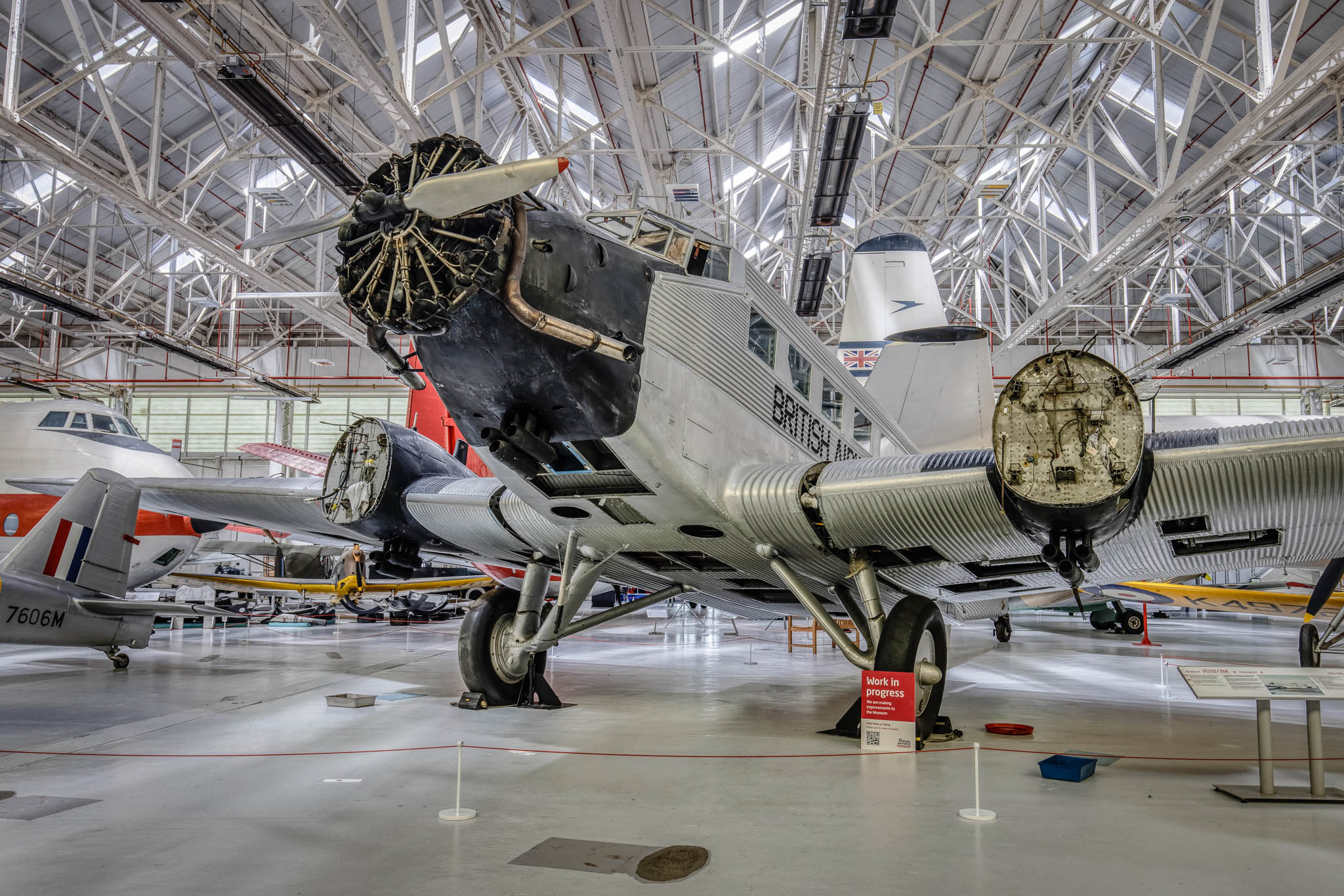 |
| Casa 352L (T.2B-272 marked 'G-AFAP'). After World War Two German designed Ju 52 was built under licence by Construcciones Aeronáuticas SA as the CASA 352 and 352L for the Spanish Air Force. Built in 1954 at Getafe it was one of 170 built. It was retired in 1972. Purchased by the RAF Museum in 1977 and flown to the UK in 1978 and painted in fictitious British Airways markings due to their sponsorship. It was being dismantled in November 2022 for transfer to the Battle of Britain museum in Hawkinge. The Museum had to call on Spanish technicians who came to assist with the removal of the wings. |
| Auster T.7 'Antarctic' (WE600) It was modified for the 1956 Trans Antarctic Expedition. The T.7 was based on the AOP.6 version and first flew in 1947. 77 examples were built. Gifted to the Midland Air Museum in October 2022. |
| Bristol 188 (XF926). Mostly built of stainless steel this research aircraft was designed to test the effect of heat build-up when flown at very high speeds. It first flew in April 1962 and eventually achieved a speed of Mach 1.88. Failing to reach the planned Mach 2 the project was abandoned in 1964 with only two aircraft built. Following storage at Filton and some years at the Proof and Experimental Establishment at Shoeburyness, XF926 eluded destruction to be moved to Cosford in 1974. From around September 2023 it was no longer on display. |
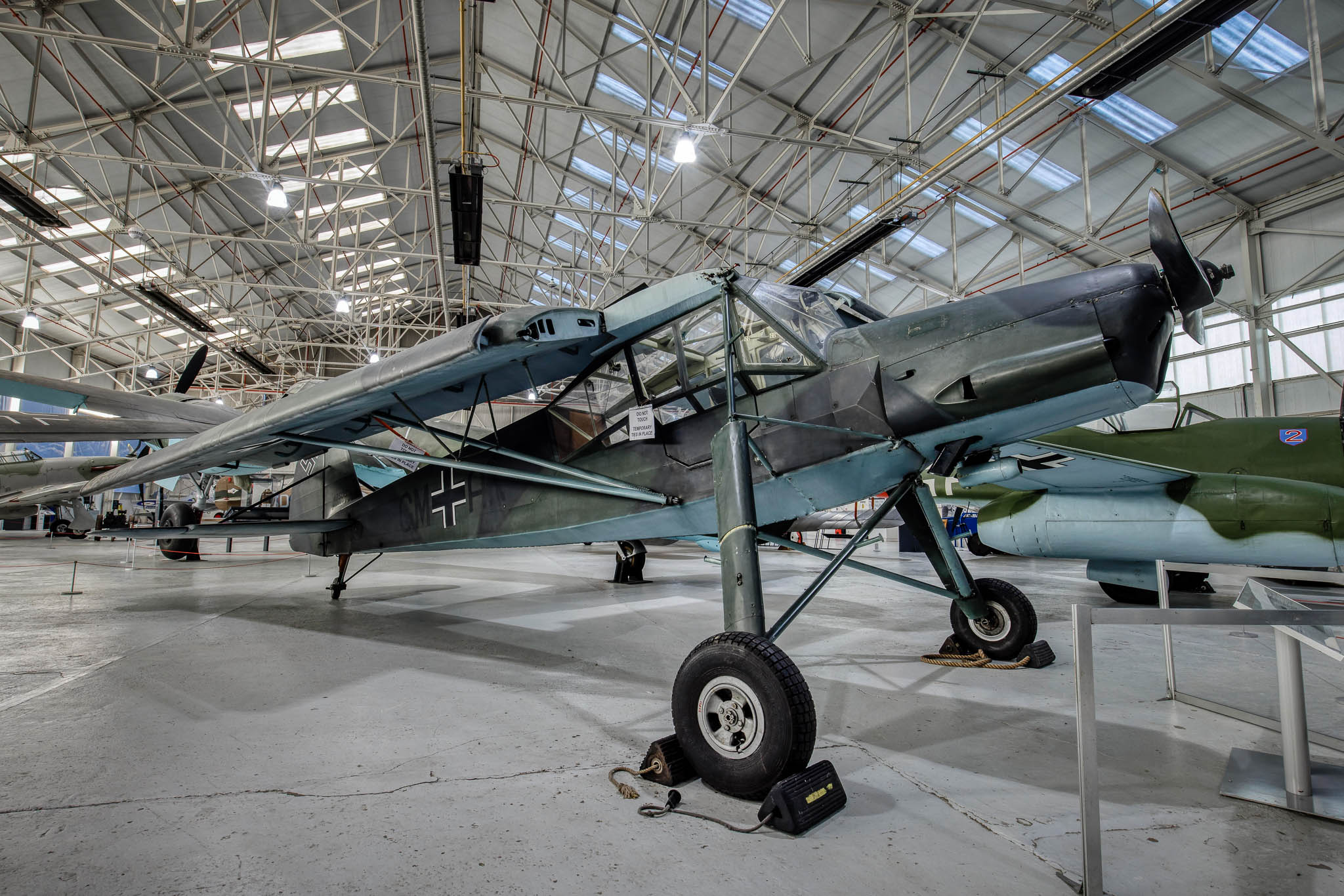 |
| Fieseler Fi 156C-7 Storch (Stork) (475081 'GM+AK' later AM.101, VP546 and 7362M). Designed in 1935 the Storch was able to fulfil a variety of roles due to its incredible Short-Take-Off and Landing (STOL) capabilities. 2,549 examples were built in Germany, Czechoslovakia and France. This particular example was built by Mraz in Czechoslovakia and was captured in 1945. Shipped back to Farnborough it was test flown until 1955. Flying from RNAS Ford, Lt Cdr Eric Brown used it for deck landings on HMS Triumph in May 1946. After a period of storage RAF Halton it was transported to various locations it was put on display with the Historic Aircraft Collection at St Athan in 1973, before being moved to Cosford in 1989. By October 2023 it was to be found in the Michael Beetham Conservation Centre (MBCC) beside the museum. It was moved in June 2025 to the Kent Battle of Britain Museum at Hawkinge, Kent. |






















